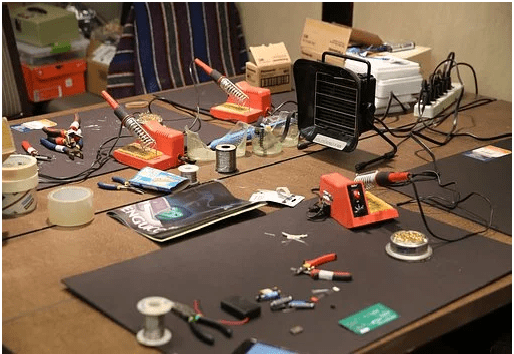What comes to mind when we think about ?good? electronics assemblies? All industries have certain acceptability criteria, so meeting these requirements makes electronics assemblies ?good,? right? Well, not exactly. In electronic products, consumer demands are pretty high. So, for any electronic assembly to be considered ?good? or ?high-quality,? it must be reliable in the long-term.
Assembling Printed Circuit Boards (PCBs) or soldering these devices are extremely complex processes. The PCB needs to have perfect finishes and integrations with various components. The solder keeping these components needs to be perfect either. Any irregular spacing or misunderstanding about industry requirements can lead to expensive repairs.
That?s why all electronics manufacturing companies abide by a single standard while determining whether electronic assemblies are acceptable or not. In the world of soldering and producing PCB assemblies, this all-important standard is the IPC-A-610.
What is the IPC-A-610 Standard?
The IPC-A-610 Standard, also known as the ?Acceptability of Electronic Assemblies,? is a set of guidelines put forward by the Institute of Printed Circuits (IPC). It?s the agreed standard that industry professionals use to define quality standards in PCB production processes. The IPC has numerous standards that dictate different aspects of PCB production, soldering, etc.
In 2020, the IPC released 21 new revisions to previous standards. The IPC-A-610 Standard was updated with an ?H? revision in September 2020. The IPC-A-610H standard will now be used by all professionals involved in the global electronics manufacturing industry to determine whether or not electronic assemblies meet specific acceptance criteria.
Why is the IPC-A-610 Standard and its Latest Revision Important?
Of all IPC standards, the IPC-A-610 standard (Acceptability of Electronic Assemblies) is one most-used. It has served as the foundational document for inspecting PCB assemblies for all OEMs for decades. Hence, any revisions to this standard are mentioned in contract documents.
If you?re an inspector working for any electronics manufacturing company, you will have to know the latest H Revision to do your job correctly. Similarly, if you?re a soldering professional aiding in the manufacture of electronic products for any OEM, you?ll have to know the IPC-A-610H standard to maintain quality.
What Does the IPC-A-610H Standard Aim to Achieve?
The IPC-A-610H standard strictly defines the criteria that PCB assemblies must meet to be considered ?acceptable? in the global electronics manufacturing industry. Here are some provisions mentioned in the IPC-A-610H Standard ?
- Guidelines on applying conformal coatings.
- Rules regarding cleanliness at PCB assembly facilities.
- Soldering requirements for through-hole mounting and surface mounting (the two existing techniques of mounting PCBs on electronic devices).
- Specific mounting requirements for different types of devices (spacing requirements, orientations of the boards, acceptable ways to build connections, etc.)
- Terminal requirements for soldering.
As long as OEMs and industry professionals abide by these standards, they?ll be able to create manufacturing processes that only produce high-quality electronic assemblies. Plus, when all industry professionals are on the same page regarding specific process requirements and what?s acceptable or not for soldered electrical components, there are significantly fewer risks of errors or miscommunications.
The IPC-A-610 standard starts off by covering general topics like inspection methodologies, the definition of requirements, acceptable materials, etc. From the third chapter onwards, more nuanced subjects like the importance of creating lead-free connections, specific guidelines on processes like tombstoning, de-wetting, etc., are covered.
Like all previous standards released by the IPC, the IPC-A-610 standard was developed and revised by committees containing leaders of the electronics industry (CEOs, chief of operations, etc.). What makes the ?H? revision to this standard unique is the fact that over 29 countries were involved in its creation.
Hence, the changes to this revision are wide-ranging and hard to grasp for non-specialists. Some of these revisions to the IPC-A-610 standard include ?
- Excerpts from other IPC standards like the IPC-A-620D standard and the IPC-J-STD-001H standard that now need to be considered while assessing PCBs.
- More pictures have been added to clarify certain concepts and notions. Although the pictorial information on certain topics addressed in this revised standard has been added with the intention to make certain subject matters less complex, if interpreted incorrectly, they can lead to miscommunications or misunderstandings.
- New requirements regarding the use of X-RAY devices for inspecting solder joints.
- There?s a separate topic on Electrostatic discharges (ESDs).
- A new section called ?Cleaning and Residue Requirements.?
- The two topics of circuit board assemblies and cable/wire harnesses were separated. The two topics now have dedicated chapters.
Applying the Revised Standards
50-70% of PCB defects happen because of improper solder printing or other types of mistakes made by soldering professionals. With this H Revision, the IPC aims to expand the reach of their standards and cut down manual errors across the world. That?s why so many countries were involved in developing the IPC-A-610H standard.
Hence, manufacturers who recruit certified masters of?IPC-A-610H Inspection?to give their assembly line staff training on these revised standards are likelier to create cultures of discipline and focus at their manufacturing facilities!

As the editor of the blog, She curate insightful content that sparks curiosity and fosters learning. With a passion for storytelling and a keen eye for detail, she strive to bring diverse perspectives and engaging narratives to readers, ensuring every piece informs, inspires, and enriches.










